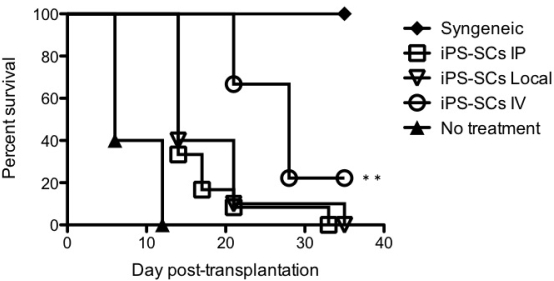Induction of iNOS Expressed Macrophages from Mouse iPS cells That Contribute to Prolong Same iPS Cells-Derived Graft Survival in Allogeneic Recipients
1Genitourinary Surgery, Hokkaido University, Sapporo, Japan
2Institute for Genetic Medicine, Hokkaido University, Sapporo, Japan.
Meeting: 2015 American Transplant Congress
Abstract number: B51
Keywords: Immunosuppression, Nitric oxide, Stem cells, T cells
Session Information
Session Name: Poster Session B: Cell Transplantation and Cell Therapies
Session Type: Poster Session
Date: Sunday, May 3, 2015
Session Time: 5:30pm-6:30pm
 Presentation Time: 5:30pm-6:30pm
Presentation Time: 5:30pm-6:30pm
Location: Exhibit Hall E
BACKGROUND: Induced pluripotent stem cells (iPSCs)-technology provides new opportunities in regenerative medicine to generate grafts from donors for transplantation. However, particularly when allogeneic iPSCs are used, immune suppression is required to avoid rejection of iPSCs-derived grafts. In this study, we examine a concept that immunosuppressive cells can be induced from iPSCs which may contribute to prolong survival of same iPSCs-derived allografts.
METHODS: Mouse iPSCs were generated from mouse fibroblasts and then differentiated into immunosuppressive cells by using culture protocol including GM-CSF, M-CSF, IL-4 and LPS. Adherent clusters were collected and examined for the ability to suppress allogeneic T and B cell responses, and the contribution to prolong allogeneic graft-survival in a transplantation model.
RESULTS: Myeloid cells with immunosuppressive features were successfully induced from iPSCs, and thus referred to as iPSCs-derived suppressive cells (iPS-SCs). iPS-SCs resemble macrophages in terms of cell surface molecules(such as CD14, CD11b, F4/80, CD206 and MHC class II) and macrophage-related gene expressions including Nos2. iPS-SCs efficiently suppressed allogeneic T and B cell proliferation in a nitric oxide dependent manner. Furthermore, iPS-SCs were found to substantially prolong survival of iPSCs-derived grafts such as embryoid bodies and cardiomyocytes in in vivo allogeneic transplantation model.
CONCLUSIONS: A certain fraction of macrophage-like cells with immunosuppressive functions can be generated from donor iPSCs, which contribute to prolong survival of same iPSCs-derived grafts in allogeneic recipients. These results suggest a new immunosuppressive strategy of combined donor iPSCs-derived graft and immunosuppressive cells transplantation in regenerative medicine using iPSCs.
To cite this abstract in AMA style:
Sasaki H, Wada H, Morita K, Seino K-I, Shinohara N. Induction of iNOS Expressed Macrophages from Mouse iPS cells That Contribute to Prolong Same iPS Cells-Derived Graft Survival in Allogeneic Recipients [abstract]. Am J Transplant. 2015; 15 (suppl 3). https://atcmeetingabstracts.com/abstract/induction-of-inos-expressed-macrophages-from-mouse-ips-cells-that-contribute-to-prolong-same-ips-cells-derived-graft-survival-in-allogeneic-recipients/. Accessed November 24, 2025.« Back to 2015 American Transplant Congress
